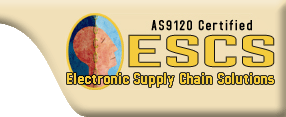 You can't catch what you're not looking for.
You can't catch what you're not looking for.
Inspection can't be your only line of defense; but your ability to avoid counterfeits is only as good as the
inspection processes used to detect them.
When sourcing components through the independent market, how do you ensure a competent and consistently applied
inspection process is being used?
What standard should you hold your distributors to?
How can you know it's being done right, every time?
What in-house inspection do you need in your receiving function?
To answer these questions, you need an understanding of current industry best practices, and a
realistic assessment of your company's unique operational requirements.
Below we outline current industry practices, initiatives and resources available to you in developing a policy
that will most effectively protect your company's supply chain.
|
|
|
What needs to be inspected?
|
Components ordered directly from the manufacturer or an authorized franchise present the least risk, yet
it's still prudent to perform in-bound visual inspection. It's not unheard of for an authorized distributor
to accept returns which are then co-mingled with stock received directly from the manufacturer. Your receiving
group needs a clear standard of visual tests to be performed.
Components ordered through an independent distributor should be subject to a more in-depth inspection process,
and be further tested for authenticity and functionality. This should be completed before the parts
are shipped to you, and your purchase order conditions should explicity state your testing and documentation requirements.
|
What inspection and testing can be done?
|
Various standards and checklists have been defined to determine component authenticity and confirm functionality.
In general, these fall into four classes:
Logical assessment - confirming manufacturer, date code, and QPL
Visual inspection - evidence of remarking, re-use and other tricks
Destructive testing - marking permanency, de-lidding, x-ray, etc.
Functionality testing - performance to mil-spec and manufacturer's specifications
|
|
Available inspection standards & check-lists
|
To date, there is no auditied inspection standard for testing of electronic components to confirm authenticity or functionality.
There are, however, some resources available that attempt to define the specific visual and invasive test methods that can form the
basis for a sound standard of inspection.
Electronic Supply Chain Solutions has taken "the best of the best" in available component inspection testing methods, and has
combined that with their own experience-based knowledge of electronic component inspection. The result is a very comprehensive
testing protocol that is available for all manufacturers and distributor's use.
For more information on obtaining a copy of the
ESCS Inspection Protocol, find out more here.
ERAI's inspection "checklist" can be downloaded
at this link.
The SAE has issued a new standard for adoption by aerospace and military manufactuers, the AS5553, "Counterfeit Electronic
Parts; Avoidance, Detection, Mitigation & Disposal", which includes a framework of expectations manufacturers should have for
the independent distributors they use in their procurement operations. An excellent summary was presented at the Supply Chain
2008 Conference, including a detailed outline of the inspection procedures
included in the standard. View the presentation here.
The Independent Distributors of Electronics Association (IDEA)provides a more formalized inspection process, the IDEA 1010-A standard.
A copy of the standard may be purchased through IDEA, and can be found at this link.
They also have a certification program for inspectors, the IDEA-ICE-3000. Information on this program can be found
at this link.
Component Technology Institute, Inc. has a Counterfeit Components Avoidance Program, based on the inspection and control
guidelines published in their "CCAP-101" documentation. CTI also provides training and certification to apply their
program. Information on this program can be found here,
on their company website.
|
|
Professional Test Services
|
Comprehensive inspection and testing for authenticity and functionality can be performed by a professional third party "test house".
There are many inspection companies to choose from, and CombatCounterfeits.com does not endorse any particular firm. IDEA has published
their own list of recommended test houses, which can be found
at this link.
|
|
The Need for an Audited Inspection Standard
|
The above listed links provide resources that can form the basis for a sound inspection and testing protocol that aerospace and military
contractors and manufacturers can use in assessing what can and should be done by their independent distributors to ensure they receive
only authentic electronic components. None of these, however, provide any assurances that a given inspection and testing protocol
is actually being applied in a consistent and professional way.
Electronic Supply Chain Solutions believes the best long-term solution for the industry is the implementation of an independently audited
inspection standard. Regardless of how well-informed a distributor may be on testing methods, only an audited standard can provide
evidence-based proof that such standards are being properly and consistently applied. ESCS supports current industry considerations
of how such a standard could be implemented. Objective annual audits of actual inspection performance are the only method of
ensuring adherence to a testing protocol.
The Aerospace Industry Association currently has a sub-team of the Counterfeit Parts Team who we understand are considering how such an
audited standard might be developed. To date, as far as we are aware, there has been no formal initiative or statement of progress
on this issue.
|
|
|
ESCS Inspection Protocol
|
Electronic Supply Chain Solutions, Inc. has taken "the best of the best" in available component inspection testing methods, and has
combined that with their own experience-based knowledge of electronic component inspection. The result is a very comprehensive
testing protocol that is available for all manufacturers and distributor's use.
For more information on obtaining a copy of the
ESCS Inspection Protocol, find out more here.
|
|
|
ESCS Inspection Consultation
|
|
ESCS provides free consultation to aerospace and military manufacturers on a range of topics related to counterfeit risk
mitigation. Contact us to discuss your specific operational requirements for inspection and testing.
|
|



